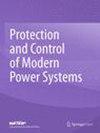基于混合算法优化的双度分支型2型模糊控制器用于可再生能源三区电力系统的频率调节
IF 11.9
1区 工程技术
Q1 ENERGY & FUELS
引用次数: 0
摘要
与多区域电力系统相关的不确定性包括热电和分布式可再生能源发电(DRG),如太阳能和风能,需要使用有效的负荷频率控制(LFC)技术。因此,本文提出了一种混合的元启发式算法(算术优化和非洲秃鹫优化算法)。它被称为“算法优化的非洲秃鹫优化算法(AOAVOA)”。利用该算法对一种新型的基于2型模糊比例导数分支的双自由度比例积分导数控制器进行了调优,用于三区混合无调节电力系统的LFC。热、电动汽车(EV)和DRG源(包括太阳能电池板和风力涡轮机系统)连接在区域1。第2区涉及热力和燃气发电装置,而第3区则连接热力和地热装置。实际的限制,如热锅炉动力学,热调速器死带,和发电速率的限制也被考虑。通过与其他控制器和优化器的比较,证明了LFC方法在抑制阶跃和随机负载干扰方面的优越性。作为储能单元,电动汽车和DRG单元可以增强高峰需求时的动态响应。因此,本文还研究了上述单元对动态反应的影响。为了验证其有效性,对闭环系统进行了鲁棒稳定性分析,并与文献中现有的各种控制方案进行了比较。结果表明,所提出的AOAVOA比算法优化器(AO)的适应度提高了40.20%,而频率调节比基于AO的2型模糊分支控制器提高了4.55%。本文章由计算机程序翻译,如有差异,请以英文原文为准。
Dual degree branched type-2 fuzzy controller optimized with a hybrid algorithm for frequency regulation in a triple-area power system integrated with renewable sources
Abstract The uncertainties associated with multi-area power systems comprising both thermal and distributed renewable generation (DRG) sources such as solar and wind necessitate the use of an efficient load frequency control (LFC) technique. Therefore, a hybrid version of two metaheuristic algorithms (arithmetic optimization and African vulture's optimization algorithm) is developed. It is called the ‘arithmetic optimized African vulture's optimization algorithm (AOAVOA)’. This algorithm is used to tune a novel type-2 fuzzy-based proportional–derivative branched with dual degree-of-freedom proportional–integral–derivative controller for the LFC of a three-area hybrid deregulated power system. Thermal, electric vehicle (EV), and DRG sources (including a solar panel and a wind turbine system) are connected in area-1. Area-2 involves thermal and gas-generating units (GUs), while thermal and geothermal units are linked in area-3. Practical restrictions such as thermo-boiler dynamics, thermal-governor dead-band, and generation rate constraints are also considered. The proposed LFC method is compared to other controllers and optimizers to demonstrate its superiority in rejecting step and random load disturbances. By functioning as energy storage elements, EVs and DRG units can enhance dynamic responses during peak demand. As a result, the effect of the aforementioned units on dynamic reactions is also investigated. To validate its effectiveness, the closed-loop system is subjected to robust stability analysis and is compared to various existing control schemes from the literature. It is determined that the suggested AOAVOA improves fitness by 40.20% over the arithmetic optimizer (AO), while frequency regulation is improved by 4.55% over an AO-tuned type-2 fuzzy-based branched controller.
求助全文
通过发布文献求助,成功后即可免费获取论文全文。
去求助
来源期刊
CiteScore
20.10
自引率
8.20%
发文量
43
审稿时长
4 weeks
期刊介绍:
Protection and Control of Modern Power Systems (PCMP) is the first international modern power system protection and control journal originated in China. The journal is dedicated to presenting top-level academic achievements in this field and aims to provide a platform for international researchers and engineers, with a special focus on authors from China, to maximize the papers' impact worldwide and contribute to the development of the power industry. PCMP is sponsored by Xuchang Ketop Electrical Research Institute and is edited and published by Power System Protection and Control Press.
PCMP focuses on advanced views, techniques, methodologies, and experience in the field of protection and control of modern power systems to showcase the latest technological achievements. However, it is important to note that the journal will cease to be published by SpringerOpen as of 31 December 2023. Nonetheless, it will continue in cooperation with a new publisher.

 求助内容:
求助内容: 应助结果提醒方式:
应助结果提醒方式:


